Karnataka has six indigenous cattle breeds of which the Deoni cattle breed is the only dual breed. Deoni male animals are used for ploughing and transportation, whereas cows yield up to 1,500 kg of milk per lactation. As the state does not have any prominent milch breed, the dairy farmers use crossbred cattle for milk production. The balance five registered breeds are Amritmahal, Hallikar, Khilari, Krishna Valley and Malnad Gidda which are draught breeds. The male animal of these breeds is excellent for ploughing and transportation, whereas cows are poor milk yielders with an average milk yield of less than 500 kg per lactation. These animals are sturdy and can with stand adverse climatic conditions. Historically, Amritmahal cattle was used by Nawab Hyder Ali and Tipu Sultan for carrying ammunition into the battlefield on rough roads and across difficult terrains. Both Amritmahal and Krishna Valley breeds are being considered for conservation under recently launched ‘Rashtriya Gokul Mission’. Pandharpuri buffaloes are reared mostly in northern Karnataka. The breed is popular due to rapid reproductive ability. Normally, this buffalo yields 6-7 liters of milk per day. But under good management, the yield can go up to 15 liters.
1.1: Distribution of Cattle Breeds of Karnataka
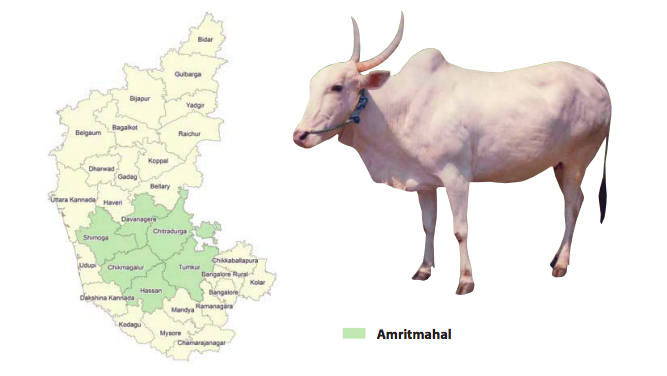
1. Amrithmahal
The Amrit Mahal is a breed of cattle that originated from the erstwhile state of Mysore in Karnataka, India. They originated from the Hallikar and closely related breeds, Hagalavadi and Chithradurg. Originally developed for use in war for transporting equipage, the bullocks are notable for their great endurance and speed. Their head is elongated with a ridge in the middle and a bulging forehead. The cows in contrast are poor milk-yielders and hence, are classified to be a draught breed.
The Amrit Mahal is one of the two breeds, along with Hallikar, which have received the royal patronage and care from the erstwhile Vijayanagara Kingdom, sultans and princely state of Mysore through conservation and development.
The breed was originally maintained by a cattle-herding community known as the Gollas, among whom were another group known as the Hallikars. During Chikka Devaraja Wadiyar’s reign a department was created within his administration known as “Benne chavadi” literally “butter department” which maintained cows and bulls, branded (with his initial ದೇ /Dē/) and maintained for supplying butter and milk to the royal household. This was taken over by Hyder Ali and he renamed the administrative unit as “Amrit Mahal”. The British took an interest in these cattle when Hyder Ali used them to move guns 100 miles in two days to Chelambram during the Battle of Porto Novo and when Tipu Sultan used them to march across south India in a month. They were then adopted for use in the army by the Duke of Wellington. After the defeat of Tipu Sultan, the British allowed them to be maintained by the Maharaja of Mysore but in thirteen years they were found to have regressed. In 1813, the pasture lands known as kaval or Kaaval (Kannada:ಕಾವಲ್) and the cattle were placed under a Captain Harvey of the Madras Commissariat for management of the breed. In 1842, a report stated that the English Army was served efficiently by 230 Mysore bullocks in Afghanistan. In 1860, Charles Trevelyan closed down this unit as being uneconomical but it was re-established in 1867 with the assistance of the Mysore Maharaja and by 1870 about 4000 cows and 100 bulls were under government care. The charge moved back to the Maharaja of Mysore in 1883.
The kavals were classified for use in wet, dry and cold weather. The cows would not come into season in the wet malnad regions but had to be taken into the dry plains where they bred. Beginning in the 20th century, the kavals were increasingly diverted for other uses.
Click to read more about Amritmahal cattle breed..
2. Deoni
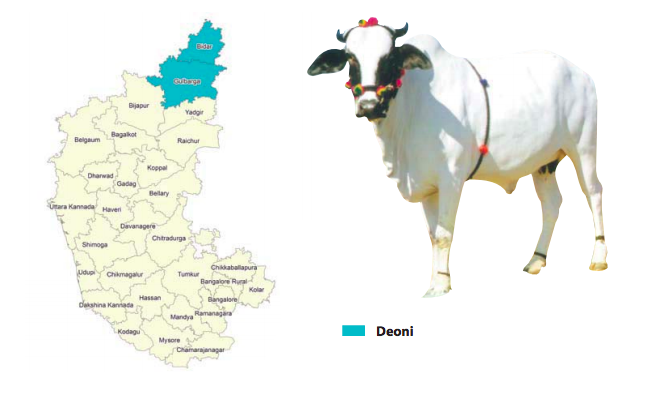
The Deoni is an Indian breed of draught cattle. It is named after the taluk of Deoni in the Latur district of Maharashtra state, and is distributed mainly in the Latur, Nanded, Osmanabad and Parbhani districts of the Marathwada region of Maharashtra, as well as the Bidar district of Karnataka.
Click to read more about Deoni Cattle breed…
3. Hallikar
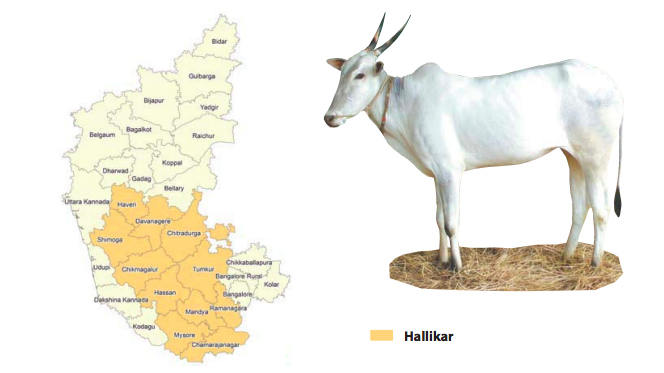
Hallikar is a breed of cattle native to the state of Karnataka, India. They are more common in the traditional Hallikar belt of Mysore, Mandya, Hassan and Tumkur districts of South Karnataka.
Long, vertical and backward bending horns, large humps in males, moderate to long height and medium size of the body, and white to grey and occasionally black complexions, are the characteristics of the breed. The bulls of this breed of cattle are known for their strength and endurance, and are mainly used for draft purposes. It is classified as a draught breed in India.
It is one of the two breeds, along with Amrit Mahal, which have received the royal patronage and care from the erstwhile Maharajas of Mysore State through conservation and development. The breed is said to be the origin of Amrit Mahal cattle.
The Department of Posts, Government of India commemorated the breed by releasing a postage stamp in its name in 2000.
Click to read more about Hallikar…
4. Khilari
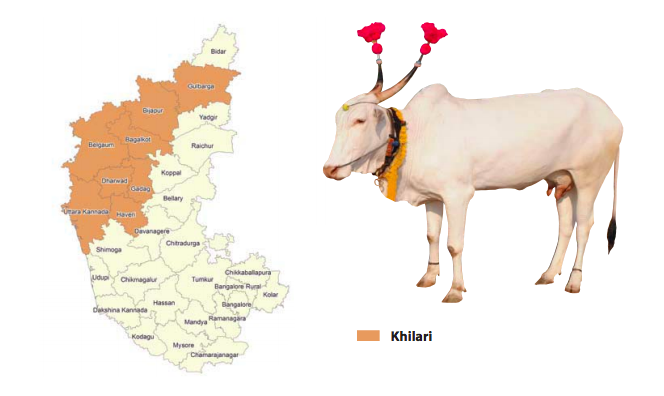
The Khillari is a cattle breed. It is a member of the Bos indicus sub-species, native to Satara, Kolhapur and Sangli regions in Maharashtra and Bijapur, Dharwad and Belgaum districts of Karnataka in India. The breed is well adapted to the area’s tropical and drought-prone conditions. They are favoured by the local farming community due to their ability to handle the hardships of farming. The breed is in decline, mostly due low milk yield, which offers an alternate income stream.
The Khillari breed includes several varieties. It possibly owes its origin to the Hillikar breed of cattle from Mysore State or Maharashtra state. The name comes from “Khillar” meaning a herd of cattle, and Khillari meaning the herdsman. Mostly Khillari bulls are basically from Satara District of South Maharashtra.& also this animals are found in neighbouring districts of Sangli, Kolhapur and Solapur of Western Maharashtra. Besides their extensive use in their home tracts they are used in the adjacent districts of Pune, Ahmednager, Nasik and Bijapur.
Click to read more about khillari cattle…
5. Krishna Valley
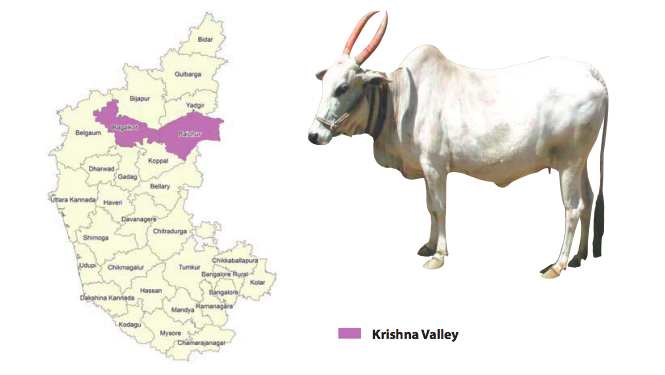
The Krishna Valley is an Indian breed of draught cattle. It originated in the areas drained by the Krishna, Ghataprabha and Malaprabha rivers. It is a recently-created breed, bred in the late nineteenth century as a draught animal for agricultural purposes.
The Krishna Valley is a relatively modern breed. It was bred from about 1880 by the Mahratta Rajas of the southern part of Hyderabad State (now Maharashtra). A local breed known as Gaonti was cross-bred with Gir, Kankrej and Ongole, with selection for the power and size needed to plough the sticky soil of the valleys of the Krishna River and its tributaries such as the Ghatprabha and the Malaprabha. Its range included the districts of Sangli, Satara and Solapur in Maharashtra, and of Belgaum, Bijapur and Raichur in Karnataka. The Rao of Sangli was a noted breeder of these cattle.
In 1946 the total breed population was estimated to be approximately 650 000; by 2012 it was believed that the number had fallen below 1000 head. The range of the breed has contracted, and it is now found only in northern Karnataka, in the districts of Bagalkot, Belgaum and Bijapur. A breed conservation programme was started in the early twenty-first century. Semen was collected from eight selected bulls; more than 4000 doses were used for artificial insemination, and another 8000 doses were frozen for conservation in the gene bank of the National Bureau of Animal Genetic Resources. A small conservation herd is kept at Bangalore.
Click to read more about Krishna Valley…
6. Malnad Gidda
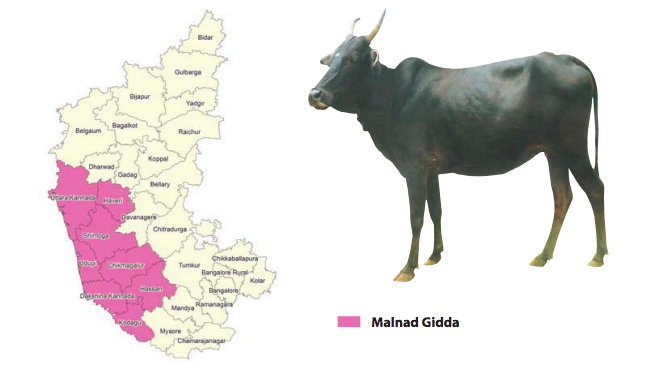
Malnad Gidda or Malenadu Gidda is a dwarf breed of cattle native to the hilly, rainy and densely forested Malenadu region of the Western Ghats in the state of Karnataka in India. It is also known as Uradana and Varshagandhi. They are of short stature and known for their adaptability, disease resistance. The milk and urine are considered to be of medicinal value. The cattle can also be sustained solely on grazing the forests and rural terrains. They are found to be of Black to brown complexions and are very shy in temperament. The breed which was once a non-descript variety has now been declared officially as a distinct breed by the authorities.
Click to read more about Malnad Gidda cattle breed..
Exotic Breeds
1.Jersey Crossbred
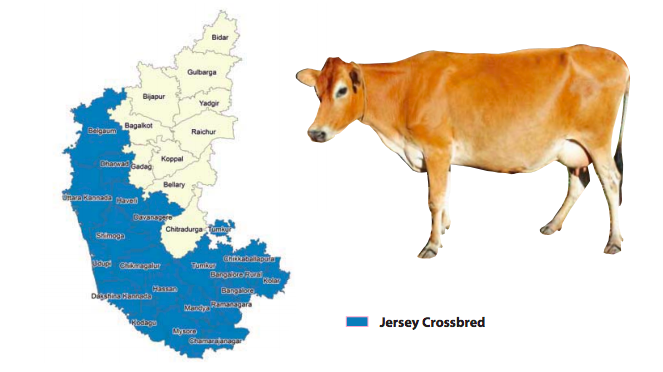
2.Holstein Friesian Crossbred
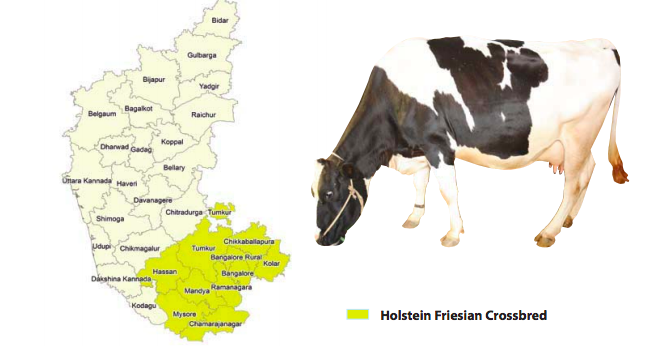
1.2: Distribution of Buffalo Breed of Karnataka
Pandharpuri Buffalo
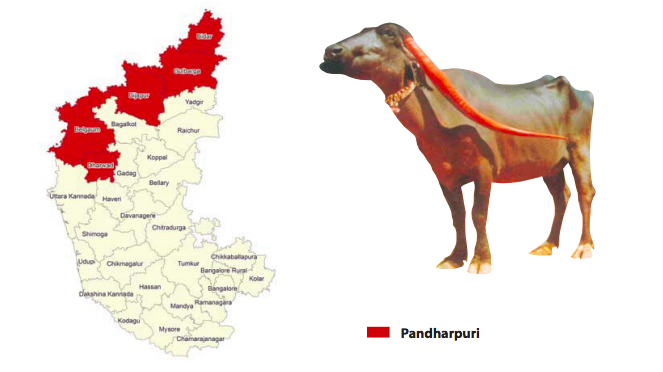
Read more about : Pandharpuri Buffalo Breed
SOURCE: AE Nivsarkar et al., (2000), Animal Genetic Resources of India, Cattle and Buffalo, ICAR publication and Department of Animal Husbandry, Dairying and Fisheries, Ministry of Agriculture, GoI